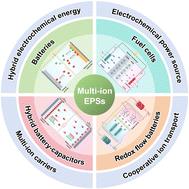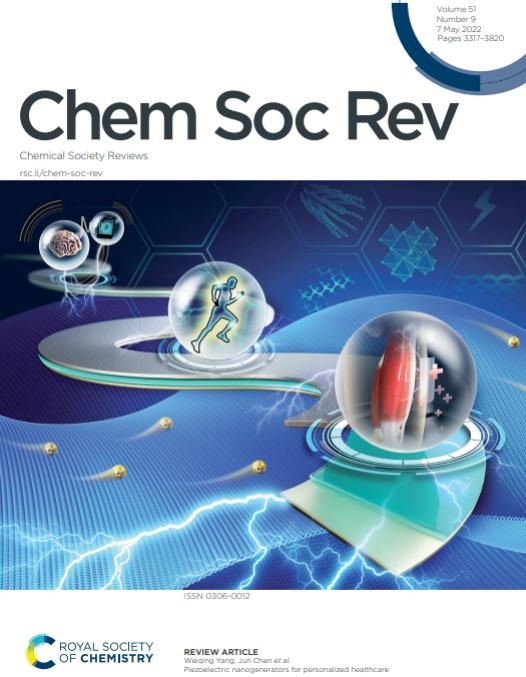Electrochemical power sources enabled by multi-ion carriers
IF 39
1区 化学
Q1 CHEMISTRY, MULTIDISCIPLINARY
引用次数: 0
Abstract
The pursuit of high-performance, sustainable, and adaptable energy storage systems stands at the forefront of addressing the ever-growing demands of our modern world. Among the most compelling frontiers in this endeavour are electrochemical technologies empowered by multi-ion carriers, which transcend the intrinsic limitations of conventional single-ion systems. By harmonizing the transport and redox behaviour of diverse cations and anions, these systems give rise to novel mechanisms of charge balance, extended electrochemical stability windows, and cooperative redox pathways. This review offers a panoramic exploration of recent advances in multi-ion carrier-enabled electrochemical energy technologies, with a particular focus on hybrid batteries, capacitors, fuel cells, and redox flow batteries. Through these case studies, we elucidate how the interplay of multiple ions governs structure–function relationships and enhances overall electrochemical performance. Central to this discussion are the underlying working principles, representative device architectures, and the latest innovations in electrode and electrolyte materials. Special attention is devoted to the way multi-ion transport phenomena unlock new electrochemical landscapes, accelerating ion kinetics, stabilizing interphases, and enabling emergent pathways unavailable to single-ion systems. We further highlight forward-looking trends in hybrid ionic configurations, such as the integration of cations, co-transport of cation–anion pairs, and the engineering of aqueous–nonaqueous hybrid systems. In closing, we provide a critical assessment of the electrochemical advantages, scalability prospects, and practical challenges that lie ahead, ranging from kinetic harmonization across multiple ions to scalable device fabrication and the mitigation of complexity-driven safety concerns. By weaving together insights from materials science, electrochemistry, and systems engineering, this review lays a foundation for the rational design of next-generation multi-ion electrochemical energy devices that promise to redefine the limits of performance and versatility.

由多离子载体实现的电化学电源
追求高性能,可持续和适应性强的储能系统站在解决我们现代世界不断增长的需求的最前沿。在这一努力中最引人注目的前沿是由多离子载体驱动的电化学技术,它超越了传统单离子系统的固有局限性。通过协调不同阳离子和阴离子的传输和氧化还原行为,这些系统产生了新的电荷平衡机制,扩展了电化学稳定窗口和协同氧化还原途径。本文综述了多离子载流子电化学能源技术的最新进展,重点介绍了混合电池、电容器、燃料电池和氧化还原液流电池。通过这些案例研究,我们阐明了多离子的相互作用如何控制结构-功能关系并提高整体电化学性能。本次讨论的核心是潜在的工作原理,代表性的器件架构,以及电极和电解质材料的最新创新。特别关注多离子传输现象如何解锁新的电化学景观,加速离子动力学,稳定界面,并使单离子系统不可用的紧急途径。我们进一步强调了混合离子构型的前瞻性趋势,如阳离子的整合,阳离子-阴离子对的共输运,以及水-非水混合体系的工程。最后,我们对电化学优势、可扩展性前景和未来的实际挑战进行了关键评估,从多个离子的动力学协调到可扩展的设备制造以及减轻复杂性驱动的安全问题。通过将材料科学、电化学和系统工程的见解结合起来,本综述为下一代多离子电化学能源装置的合理设计奠定了基础,这些装置有望重新定义性能和多功能性的限制。
本文章由计算机程序翻译,如有差异,请以英文原文为准。
求助全文
约1分钟内获得全文
求助全文
来源期刊

Chemical Society Reviews
化学-化学综合
CiteScore
80.80
自引率
1.10%
发文量
345
审稿时长
6.0 months
期刊介绍:
Chemical Society Reviews is published by: Royal Society of Chemistry.
Focus: Review articles on topics of current interest in chemistry;
Predecessors: Quarterly Reviews, Chemical Society (1947–1971);
Current title: Since 1971;
Impact factor: 60.615 (2021);
Themed issues: Occasional themed issues on new and emerging areas of research in the chemical sciences
 求助内容:
求助内容: 应助结果提醒方式:
应助结果提醒方式:


